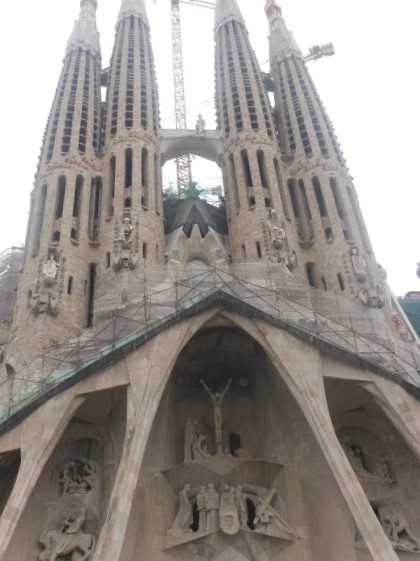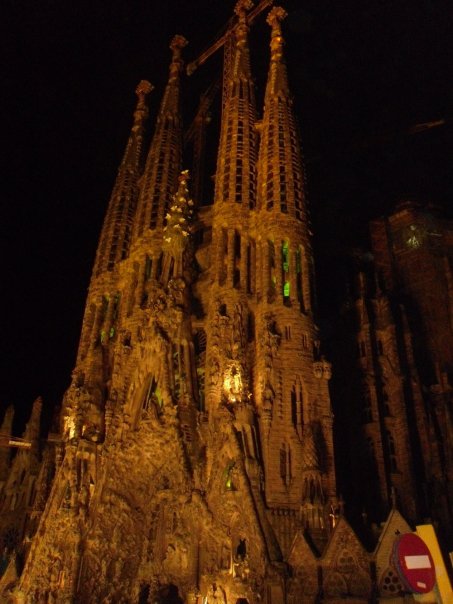The Unfinished Church in Barcelona – La Sagrada Familia
La Sagrada Familia (Holy Family) is one of the pioneering works of modern architecture in Spain, Barcelona. La Sagrada Familia is a building that the famous Spanish architect Antoni Gaudi took over the construction in 1883. It is a basilica-style church whose structure was left unfinished as a result of Antoni Gaudi’s death in 1926 by being run over by a tram. In Spain, it is also popularly known as the never-ending church. Its construction is still ongoing.
 La Sagrada Familia means Holy Family
La Sagrada Familia means Holy Family
Let’s take a look at the story of La Sagrada Familia, known as the never-ending church among the people! Although not yet completed, Sagrada Familia, which will be the most magnificent structure in the city, and will be in first place in the program of tourist guides in Barcelona, is an architecture lesson not only in terms of design but also in terms of the construction process. The work that Gaudi, who devoted almost his entire career to this building, could not see completion, is now waiting to be completed in the hands of a large architectural team.
The beginning of the story of the Sagrada Familia dates back to 1882. Gaudi became involved in the project in 1883 as a result of the ongoing disagreements between the first architect of the building, Francisco de Paula del Villar, and the supporters of the church.
It is not known whether Gaudi, who devoted his career to this structure from that day until his death, predicted a century-long period of incomplete completion, but he answered the questions asked about his work that lasted 43 years, ‘my employer is not in a hurry. The church, located in an area where cows grazed when it was started to be built, is in the middle of the city today.
Maybe if it was built a century ago, the magnificence of today’s city center surrounded by apartment blocks would have been different. On the other hand, the fact that this building, which has an architectural design symbolizing a period, was completed in a different architectural time is another element that makes the project interesting. The Sagrada Familia project, which is the product of a long and painful work, is in its 135th year today and the construction has still not been completed.
 During this long period, the construction was interrupted many times. After Gaudi died in 1926, construction begins to slow, as funding is not available and civil war breaks out. II. The outbreak of World War II deals a second blow to the construction. Moreover, the original drawings and models of the architect are badly damaged, and after that, the project continues in the form of interpretations of the remaining plans. The construction takes so long that the first parts of the building have to be restored before the construction is completed. It is the only building in history that was restored before its construction was completed.
During this long period, the construction was interrupted many times. After Gaudi died in 1926, construction begins to slow, as funding is not available and civil war breaks out. II. The outbreak of World War II deals a second blow to the construction. Moreover, the original drawings and models of the architect are badly damaged, and after that, the project continues in the form of interpretations of the remaining plans. The construction takes so long that the first parts of the building have to be restored before the construction is completed. It is the only building in history that was restored before its construction was completed.
Gaudi’s strong architectural design is another factor that complicates the construction process. Mark Burry, the lead architect of the building’s completion project, uses the phrase “a gigantic statue in the city” when describing this building.
The building, which Gaudi also dealt with with the meticulousness of a sculptor, and which contains serious details that require attention, is processed with very fine details. Despite the supporters of the complete project, which was based on guesswork as a result of the destruction of Gaudi’s original drawings, some argued that the building had lost a lot in terms of architectural style and design. For example, the use of concrete in the completion project against Gaudi’s desire to use stone in the church was interpreted as disrespecting the architect’s ideas. Daniel Giralt, the city’s MoMa director, said that “it is impossible to imitate the spirit of Gaudi” and that the construction should be terminated and Gaudi’s work should be preserved.
On the other hand, those who supported the continuation of the construction responded, “A building cannot be treated as a painting”.
Architecture school professors, who said that the project did not die even if the architect died, argued that Gaudi himself predicted that he would not be able to complete this project and that the church should be completed not to sanctify the architect, but to respect the project.
Gaudi designed the church with three different facades. The first part of the church where construction started was the Nativity Facade.
This section, whose construction was personally controlled by Gaudi, was completed between 1894-1930. It is known that Gaudi wanted to finish this façade, which contains many details that refer to the birth of Jesus, perhaps because he thought that he would not be able to see the completion of the construction. On the other hand, the Passion Facade has a very simple design despite the decorative intensity on the first façade.
Referring to the passion of Jesus, and the suffering he suffered at his crucifixion, the construction of this façade began in 1954. Between 1976-1987, a team of sculptors completed the towers of this section.
Construction of Glory Facade, the largest and most influential façade, began in 2002. A model prepared by Gaudi in 1936 is used for this facade, which is full of elements that refer to the divine glory of Jesus and the ascension of humanity to God.
After Gaudi’s death, a team of professionals from various disciplines conducts the Sagrada Familia completion project. The construction process, which is now accelerated by today’s technologies, is planned to end in 2026.
Bir yanıt yazın